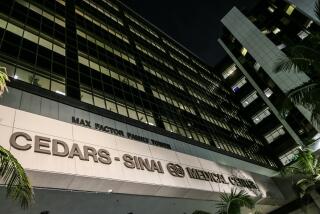Cedars-Sinai is investigated in 206 radiation overdoses
More than 200 patients at Cedars-Sinai Medical Center were inappropriately exposed to high doses of radiation from CT brain scans used to diagnose strokes, hospital officials told The Times on Friday.
About 40% of the patients lost patches of hair as a result of the overdoses, a hospital spokesman said.
Even so, the overdoses went undetected for 18 months as patients received eight times the dose normally delivered in the procedure, raising questions about why it took Cedars-Sinai so long to notice that something was wrong.
As a result of the discovery, the FDA issued an alert Thursday urging hospitals nationwide to review their safety protocols for CT scans.
“The magnitude of these overdoses and their impact on the affected patients were significant,” the alert states. “This situation may reflect more widespread problems with CT quality assurance programs and may not be isolated to this particular facility or this imaging procedure.”
The state Department of Health is also investigating the overdoses, a spokesman said.
It was unclear what led to the overdoses. “We’re looking into two possibilities,” said Peper Long, an FDA spokeswoman. “It could be the device, or it could be the procedures that were followed.”
In a written statement, Cedars-Sinai officials said they became aware of the problem in August after a patient who had received a scan -- known as a CT brain perfusion -- noticed a loss of hair, which is not a common side effect.
At that point, the hospital stopped doing scans and began to investigate, discovering that its machine had been delivering the high dose since February 2008. In all, hospital officials told 206 patients that they had received the high dose.
It was then that they learned roughly 80 people had lost at least some hair, said hospital spokesman Richard Elbaum. Although a few patients had reported the hair loss to their physicians, apparently nobody connected it to the scans, he said. Elbaum said the hair loss appeared to be temporary in all affected patients.
In its alert, the FDA instructed CT operators to pay close attention to the “dose indices displayed on the control panel” both before and after a patient is scanned. The scanner in question is made by General Electric, the FDA’s spokeswoman said.
Dr. Geoffrey Rubin, a professor of radiology at Stanford University, said most radiation departments operate under strict protocols to minimize a patient’s exposure.
“A key responsibility is understanding how much radiation you are delivering to the patient,” he said. “If you are not staying on that mandate, then things can go awry.”
CT, or computed tomography, is a procedure that uses a rapid series of X-rays to create stunningly detailed images. Doctors in the U.S. order tens of millions of CT scans each year to examine many parts of the body. Scans are standard procedure for quickly detecting a stroke, an injury in which the flow of blood to brain tissue is interrupted.
A patient undergoing a CT scan is injected with an iodine solution and, over a period of 20 seconds to a minute, the machine takes repeated images of the brain. By tracking the flow of the iodine, the series of images show which parts of the brain are receiving blood.
Doctors can get more detailed information by using more radiation. But therein lies a trade-off: In very high doses, it can cause radiation poisoning and lead to cancer years or decades later. In older patients, the risk of cancer is limited, because those patients are likely to die of other causes before the long-term effects of radiation could sicken them.
Cedars-Sinai officials, who said they immediately reported the findings of their internal investigation to state health officials, have since restarted doing CT brain perfusion scans.
The hospital had “instituted additional double-checks in its operations of the scanner and additional equipment protocols to ensure that this does not happen again,” according to the statement. Depending on the outcome of the state investigation, however, the hospital could face restrictions on doing CT scans under its state license, said Al Lundeen, a spokesman for the state Department of Public Health.
In recent years, Cedars-Sinai has been the site of other high-profile problems. In November 2007, the newborn twins of actor Dennis Quaid and his wife, Kimberly, twice were given 1,000 times the intended dosage of the blood thinner heparin, endangering their lives. State regulators later fined the hospital $25,000 for safety lapses involving the Quaid twins and another child. The Quaids sued the hospital, settling the case for $750,000. In June, a former Cedars-Sinai employee was sentenced to four years and eight months in prison after pleading guilty to stealing patient information to defraud insurance firms. Personal information from more than 1,000 patients was found during a search of the man’s home.
--
Times staff writer Molly Hennessy-Fiske contributed to this report.
More to Read
Sign up for Essential California
The most important California stories and recommendations in your inbox every morning.
You may occasionally receive promotional content from the Los Angeles Times.











